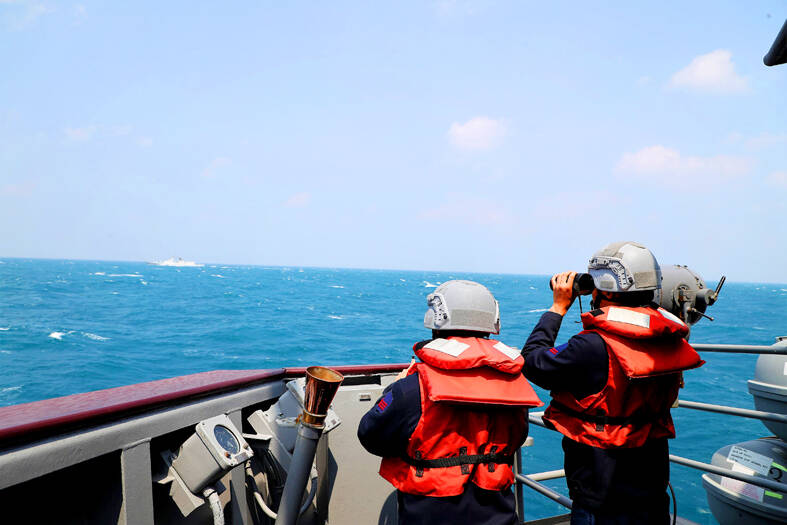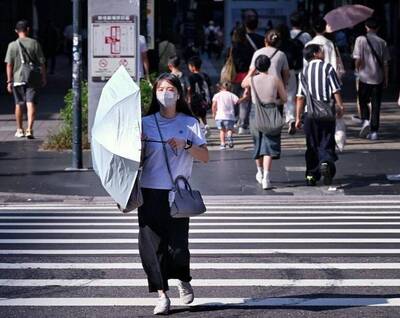Taiwanese fisher Chen Zhi-rong says that for decades it was common to sail in waters that skirted the Chinese coastline. Since Beijing seized a boat and its crew for the first time in 17 years for contravening a fishing ban — and continues to detain them — all that has changed.
The China Coast Guard is now “constantly” patrolling east of the median line in the Taiwan Strait, said Chen, referring to the US-drawn boundary that had for decades served as an unofficial barrier between the two sides.
“Fishing boats probably won’t go near Kinmen and the Chinese coast in the near future,” Chen said. “Everyone is concerned about being detained now.”

Photo: EPA-EFE / Ministry of National Defense
The fear among fishers suggests that China is turning to new tactics to pressure the democratically run, US-backed archipelago that Beijing has pledged to bring under its control someday.
Mostly using its coast guard, Beijing seems to be asserting itself in new ways around Taiwan’s outlying islands. Many of them are far from Taiwan proper and just a few kilometers from China, presenting challenges with supplies and providing services like the Internet.
The changes coincide with China squeezing President William Lai (賴清德) since he took office in May. To show its displeasure with a figure it suspects is pursuing Taiwanese independence, Beijing has held major military drills around Taiwan proper, peeled off a diplomatic ally and expanded a law it says is aimed at punishing “die-hard separatists.”
In the latest incident involving fishers, the China Coast Guard detained a Taiwanese boat and its crew near Kinmen, the most populated of Taipei’s outlying islands. The vessel and the two Taiwanese and three Indonesians aboard were taken to a Chinese port, a move the Chinese authorities said was necessary because they had contravened a summer fishing ban.
In recent months, China has also boarded a Taiwanese tourist craft near Kinmen to check documents, surprising passengers who feared they would be taken to China. That rare move escalated a spat over an incident earlier this year in which two Chinese fishers died after their boat capsized while fleeing from the Taiwanese coast guard.
Beijing has also repeatedly sent China Coast Guard vessels zipping closer to Kinmen than it ever did in the past, and its coast guard carried out maneuvers around two other islands while the Chinese People’s Liberation Army held major drills just after Lai took office — the first time that has occurred.
“China has been increasingly using Taiwan’s outlying islands to step up its pressure on Taiwan,” said Chen Yu-jie (陳玉潔), an assistant research professor at Academia Sinica in Taipei.
“Incidents like the boat seizure earlier this February were not individual episodes,” she added, saying they must be seen “within the wider context of legal warfare,” referring to law-based tactics Beijing uses to undermine Taipei.
The Chinese Ministry of Defense did not respond to a request for comment.
Asked about China’s activities around the outlying islands, a spokesperson for the Coast Guard Administration said it “had deliberately intruded into the waters of Taiwan’s outlying islands more than 30 times starting this year with the clear intention of harassment.”
Taiwan would monitor the situation and ensure the safety of its fishers, the spokesperson said.
China’s new activity around the Taiwanese islets is also reminiscent of its increasingly aggressive interactions with the Philippines. Manila and Beijing have been locked in testy confrontations around a shoal in the South China Sea where the Philippines has tried to resupply a beached World War II-era ship that serves as an outpost.
Last month, a Philippine sailor lost a thumb in a clash, and the US later said China’s actions had threatened regional peace. Manila and Beijing recently reached a “provisional” deal to try to calm tensions around the shoal, although there is signs they disagree on the pact’s specific contents.
The government in Taipei has said little publicly about the detained fishing boat and the Taiwanese crew members still in China, likely to avoid escalating the matter and to create negotiating room.
National Security Bureau Director-General Tsai Ming-yen (蔡明彥) has said that China might have been politically motivated to stop the fishing boat and its crew. He also warned Taiwanese fishers to be vigilant.
China’s detention of the vessel might also be a subtle test of the US, said Chen Fang-yu (陳方隅), an assistant professor in the Department of Political Science at Soochow University in Taipei.
While Washington backs Taipei militarily, economically and politically, its attitude to most of the outlying islands is vague.
US President Joe Biden has repeatedly said the US would defend Taiwan from a Chinese invasion, but it is unclear how the US would respond to a crisis involving any of the more than 130 islands that make up the Taiwanese archipelago.
For now, Chen Fang-yu said that previous understandings of the boundaries and overlapping waters of China and Taiwan no longer exist. “It’s likely that China will increasingly harass fishing boats and sightseeing boats to test Taiwan’s response,” he said.

Three Taiwanese airlines have prohibited passengers from packing Bluetooth earbuds and their charger cases in checked luggage. EVA Air and Uni Air said that Bluetooth earbuds and charger cases are categorized as portable electronic devices, which should be switched off if they are placed in checked luggage based on international aviation safety regulations. They must not be in standby or sleep mode. However, as charging would continue when earbuds are placed in the charger cases, which would contravene international aviation regulations, their cases must be carried as hand luggage, they said. Tigerair Taiwan said that earbud charger cases are equipped

Foreign travelers entering Taiwan on a short layover via Taiwan Taoyuan International Airport are receiving NT$600 gift vouchers from yesterday, the Tourism Administration said, adding that it hopes the incentive would boost tourism consumption at the airport. The program, which allows travelers holding non-Taiwan passports who enter the country during a layover of up to 24 hours to claim a voucher, aims to promote attractions at the airport, the agency said in a statement on Friday. To participate, travelers must sign up on the campaign Web site, the agency said. They can then present their passport and boarding pass for their connecting international

WEATHER Typhoon forming: CWA A tropical depression is expected to form into a typhoon as early as today, the Central Weather Administration (CWA) said yesterday, adding that the storm’s path remains uncertain. Before the weekend, it would move toward the Philippines, the agency said. Some time around Monday next week, it might reach a turning point, either veering north toward waters east of Taiwan or continuing westward across the Philippines, the CWA said. Meanwhile, the eye of Typhoon Kalmaegi was 1,310km south-southeast of Oluanpi (鵝鑾鼻), Taiwan’s southernmost point, as of 2am yesterday, it said. The storm is forecast to move through central

Taiwan sweltered through its hottest October on record, the Central Weather Administration (CWA) said yesterday, the latest in a string of global temperature records. The main island endured its highest average temperature since 1950, CWA forecaster Liu Pei-teng said. Temperatures the world over have soared in recent years as human-induced climate change contributes to ever more erratic weather patterns. Taiwan’s average temperature was 27.381°C as of Thursday, Liu said. Liu said the average could slip 0.1°C by the end of yesterday, but it would still be higher than the previous record of 27.009°C in 2016. "The temperature only started lowering around Oct. 18 or 19